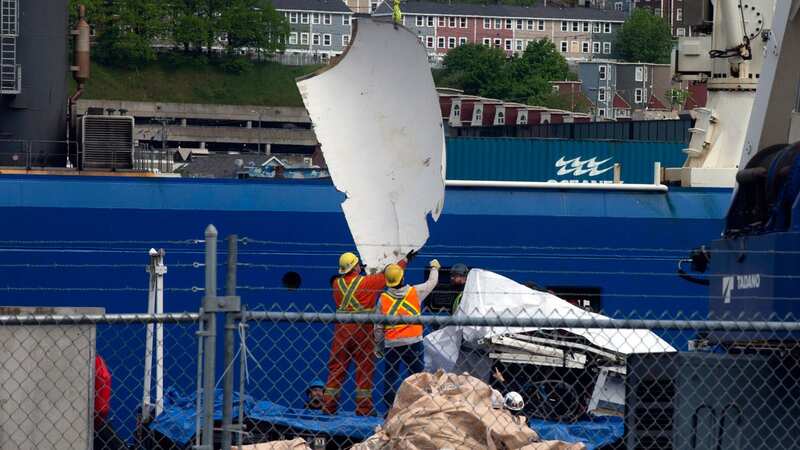Experts unravel mystery of huge Titan sub remains despite 'vaporised' wreck

When large parts of the Titan tourist submersible were recovered after a 'catastrophic implosion', people were left baffled.
The fatal tragedy on June 18, 2023, instantly killed three Brits on board the deep-sea vessel - adventurer Hamish Harding and father and son Shahzada and Suleman Dawood, who also travelled alongside OceanGate Expeditions' chief executive, Stockton Rush, and French national Paul-Henri Nargeolet.
The group was set to explore the famous Titanic wreckage located 12,500 feet beneath the ocean, but days later presumed human remains were discovered. Photos emerged of large chunks of debris being retrieved and transported to shore in St John's, Newfoundland, Canada, sparking questions about how such big pieces could survive an implosion of such magnitude.
The pieces included a large, white section of curved metal appearing to show the outer casing of the 21-ft Titan sub. Another piece showed cables, onboard computers and other mechanical parts. A large circular part of the Titan, which appeared to be the dome-shaped front section, was also found.
Nine months on, experts look to answer some of the biggest questions about the disaster in a new two-part series - The Titan Sub Disaster: Minute by Minute - which airs tonight on Channel 5 and follows the race to find the Titan submersible and its crew.
 Three theories on how Titanic wreck submarine disappeared in Atlantic Ocean
Three theories on how Titanic wreck submarine disappeared in Atlantic Ocean
 Titan submersible passengers (L-R, top to bottom) Hamish Harding, CEO Stockton Rush, Paul-Henri Nargeolet, and father and son Shahzada and Suleman Dawood (Dirty Dozen Productions/OceanGat)
Titan submersible passengers (L-R, top to bottom) Hamish Harding, CEO Stockton Rush, Paul-Henri Nargeolet, and father and son Shahzada and Suleman Dawood (Dirty Dozen Productions/OceanGat)Experts previously told NBC News that the water pressure on the sub would have been the equivalent of the 10,000-ton, wrought-iron Eiffel Tower. The force of the implosion, it was said, would have been so strong that the craft's carbon-fibre hull would have just 'suddenly vanished', vaporising and killing all inside before they knew anything was wrong.
So why were there any remains to recover in the first place? A coastguard source from St John's, where the ill-fated adventurers set off on June 17, told the Mirror the debris would be pieced back together to help with ongoing investigations - including the UK Marine Accident Investigation Branch that has been brought in to probe the tourist deaths.
The submersible's construction included at least one titanium end cap, a titanium ring and a carbon fibre cylinder. OceanGate had been previously warned by ex-staff members of the safety of the submersible after it was revealed its carbon fibre hull, which housed the five passengers, was its "Achilles heel" - because the material is not considered suitable for deep dives.
 Large parts of the vessel have been hauled from the water (AP)
Large parts of the vessel have been hauled from the water (AP)Tom Maddox, CEO of Underwater Investigators, said investigators were expecting the Titan to have been blown to pieces. "Many of us suspected that, in the case of this catastrophic failure, this implosion, that a lot of the parts would be disintegrated, particularly the non-titanium parts, which, of course, would make the investigation a lot harder to do," he told DailyMail.com.
Although finding larger remains meant investigators had "more pieces of the puzzle to put together". "They'll put it back as best they can," he said. "I don't think there's a rulebook for this, you know, there's no manual, this is something new.
"And they're going to have to kind of write the book as they go along, would be my thought, but they'll use their past experiences and their knowledge to do that."
Meanwhile, Arun Bansil, university professor of physics at Northeastern, explained a basic overview of the physics involved in the violent crash before explaining the reason why we saw such large pieces of debris. "In an explosion, the force acts outwards, but in an implosion, the force acts inwards. When a submersible is deep in the ocean it experiences the force on its surface due to water pressure," he told Northeastern Global News.
"When this force becomes larger than the force hull can withstand, the vessel implodes violently. The key is the design of the hull that protects the vessel against the large external water pressure that is trying to crush the hull."
 Debris from the Titan submersible, recovered from the ocean floor near the wreck of the Titanic, is unloaded from the ship Horizon Arctic (Canadian Press/REX/Shutterstock)
Debris from the Titan submersible, recovered from the ocean floor near the wreck of the Titanic, is unloaded from the ship Horizon Arctic (Canadian Press/REX/Shutterstock)Professor Bansil says that most of the existing technology is based on steel, titanium and aluminium, with the performance of these materials under extreme stress being well understood. He added: "However, the Titan's hull had an experimental design.
"It used mostly carbon fibres, which have the advantage of being lighter than titanium or steel, so Titan could have more space for passengers. Properties of carbon fibres for deep sea applications are, however, not that well understood. It can crack and break suddenly.
 Faces of crew missing on Titanic submarine - Brit billionaire to OceanGate CEO
Faces of crew missing on Titanic submarine - Brit billionaire to OceanGate CEO
"Titan had previously gone for deep sea dives a few times, which would have contributed to the fatigue of the hull to make the hull more prone to catastrophic failure." Speaking with the Mirror, the expert explained why we saw large parts of the vessel remain intact.
"Although it seems counterintuitive, large objects do not normally split apart into smithereens in an implosion or explosion," Prof Bansil said. "For example, a pressure cooker usually explodes with the top blown off but the body remains intact. The initial failure of Titan would have occurred at its weakest links such as defects in the hull.
"Once a crack opens, however, large pieces of the hull will no longer experience very violent forces and remain more or less intact." The Titan submersible lost contact with tour operator OceanGate Expeditions an hour and 45 minutes into the two-hour descent to the wreckage, with the vessel reported missing eight hours after communication was lost.
 The OceanGate Expeditions submersible vessel named Titan used to visit the wreckage site of the Titanic (PA)
The OceanGate Expeditions submersible vessel named Titan used to visit the wreckage site of the Titanic (PA)Stockton Rush, CEO of OceanGate, previously explained in a haunting interview that "as you're descending, you've got your depth and altitude… that's pretty critical. When you get close to the bottom, you have to be ready to drop some weight so you don't go crashing into it, or thrust.."
The billionaire, who was officially declared deceased, continued: "So getting that notification 200 metres above the bottom is pretty critical. And then when we use our laser scanning system, we need correction data for through water speed currents and the light to keep the errors down, and that’s it, that’s the element of adding [coms] on the sub."
In a statement, Captain Jason Neubauer, Chair of the Marine Board of Investigation said: "I am grateful for the coordinated international and interagency support to recover and preserve this vital evidence at extreme offshore distances and depths.
"The evidence will provide investigators from several international jurisdictions with critical insights into the cause of this tragedy. There is still a substantial amount of work to be done to understand the factors that led to the catastrophic loss of the Titan and help ensure a similar tragedy does not occur again."
At the time, OceanGate said it was "an extremely sad time for our employees who are exhausted and grieving deeply over this loss".
The Titan Sub Disaster: Minute By Minute airs this evening (Wednesday, March 6), at 9pm on Channel 5.
Read more similar news:
Comments:
comments powered by Disqus

































